Michael J. Behe's Blog, page 492
April 23, 2019
“Honey, I ate the kids” cited as evidence of Darwinism at work
From ScienceDaily:
Now researchers at the University of Tennessee and the University of Oxford suggest that in some cases, filial cannibalism and offspring abandonment might even be considered forms of parental care. Published in Frontiers in Ecology and Evolution, their mathematical model shows that when overcrowding threatens offspring survival — which often occurs due to spread of infection or competition for resources — sacrificing a few so the most can live becomes the ultimate form of tough love.
They created a mathematical model that, they say, demonstrates: Live fast, die young, be prepared to abort
“The fitness benefit of offspring abandonment and filial cannibalism also increases as adult death rate increases, particularly for the case of filial cannibalism,” adds co-author Prof. Michael Bonsall of the University of Oxford.
In other words: if you’ve got fewer shots at reproducing, you’ll need to be ruthless in protecting your brood. But if offspring mortality is density dependent, why produce so many eggs in the first place?
“It is not always possible for parents to predict the environment that their offspring will end up in,” explains Bonsall. “Factors like food availability, oxygen availability, diseases presence and predation, might change in an unpredictable manner. Likewise, in many fish and other animals females deposit their eggs in the nests or territories of males and leave, so cannot predict an optimal laying density given that additional females might subsequently add eggs to the nest.”
“It’s up to empiricists now to test these models in a variety of species,” the authors conclude. Paper. (open access) – Mackenzie E. Davenport, Michael B. Bonsall, Hope Klug. Unconventional Care: Offspring Abandonment and Filial Cannibalism Can Function as Forms of Parental Care. Frontiers in Ecology and Evolution, 2019; 7 DOI: 10.3389/fevo.2019.00113 More.
Here’s how you can tell that Darwinian evolution (natural selection on random mutations produces information) functions as a superstition today: Everything and its opposite is considered a demonstration. In a world where, over hundreds of thousands of years, many life forms go extinct—and an adopted behavior may, over a long period of time, be a factor in an extinction—the theorist assumes that whatever is happening is, on the contrary, a demonstration of Darwinian fitness — and constructs a mathematical model that supports that view.
There are all kinds of these stories out there — about why birds lay eggs in others’ nests, why stressed mares miscarry to avoid infidelity being detected, and how birds plan for their offspring’s future (Huh? Birds that can’t avoid wind turbines can plan for their offspring’s future?)
The rule in the discipline seems to be: Never call anyone to account for fronting nonsense as long as it is Darwinian nonsense.
Note: Stressed mammals do sometimes eat their offspring in the same way that a wounded dog who is being led to safety might turn and sink his teeth into the human who is helping him. But if a mammal is intellectually complex enough to have an individual psychology, please, see the behaviour as a response to the stress rather than as the unfolding of some grand Darwinian plan. We owe it to our furry domestic friends to try to understand them at least that far.
See also: Darwinian cheating story about birds not confirmed The strategy is not outstandingly successful and the researchers are now looking for an explanation other than a selective advantage. That’s wise on their part. This sounds like another strategy where the bird merely adapts; sometimes it works and sometimes it doesn’t. No big Darwin theory is needed.
Why stressed mares miscarry (going full Darwin here)
and
Birds are found to plan like humans for their offsprings’ future. Yes, the Darwinbird of pop science can do that!
Also: Sexual trappings (dimorphism) may increase the likelihood of extinction, not survival
Follow UD News at Twitter!
Copyright © 2019 Uncommon Descent . This Feed is for personal non-commercial use only. If you are not reading this material in your news aggregator, the site you are looking at is guilty of copyright infringement UNLESS EXPLICIT PERMISSION OTHERWISE HAS BEEN GIVEN. Please contact legal@uncommondescent.com so we can take legal action immediately.
Plugin by Taragana
Another look at the call to abandon statistical significance
 What’s hot? What’s not?/Niklas Bildhauer, Wikimedia
What’s hot? What’s not?/Niklas Bildhauer, Wikimedia Abandoning it certainly wouldn’t be easy because so much prior research is built around it.
More than 800 statisticians and scientists are calling for an end to judging studies by statistical significance in a March 20 comment published in Nature. An accompanying March 20 special issue of the American Statistician makes the manifesto crystal clear in its introduction: “‘statistically significant’ — don’t say it and don’t use it.”
There is good reason to want to scrap statistical significance. But with so much research now built around the concept, it’s unclear how — or with what other measures — the scientific community could replace it. The American Statistician offers a full 43 articles exploring what scientific life might look like without this measure in the mix.Bethany Brookshire, “Statisticians want to abandon science’s standard measure of ‘significance’” at Science News
In an era where even medical journals are urged to get woke, abandoning statistical significance could mean abandoning a refuge against Correct nonsense. As Brookshire writes, “Unfortunately, there is no single alternative that everyone agrees would be better for all experiments.” But that might just be what some factions want and need.
Maybe science is over and there is a war for the cultural spoils.
Follow UD News at Twitter!
See also: Pushback against abandoning statistical significance in science
When medical journals get woke… They fight racism, not cancer. We hope no one facing a difficult diagnosis has to listen to someone whose basic mission in life sounds like dumping on herself instead of serving others. .
and
Which side will atheists choose in the war on science? They need to re-evaluate their alliance with progressivism, which is doing science no favours.
Copyright © 2019 Uncommon Descent . This Feed is for personal non-commercial use only. If you are not reading this material in your news aggregator, the site you are looking at is guilty of copyright infringement UNLESS EXPLICIT PERMISSION OTHERWISE HAS BEEN GIVEN. Please contact legal@uncommondescent.com so we can take legal action immediately.
Plugin by Taragana
April 22, 2019
Drone finds Hawaiian plant, believed extinct
The plant, Hibiscadelphus woodii, was formally discovered in 1991 and had been declared extinct in 2016:
In 2016, the same year the plant was listed extinct, the National Tropical Botanical Garden teamed up with drone operator Ben Nyberg to supplement the work of intrepid scientists like Wood, who rappel down cliffs and trudge through rainforests to conserve plants. In January, National Geographic reports, Nyberg saw what looked like a Hibiscadelphus woodii plant while surveying via drone… The following month, Nyberg and Wood hiked 700 feet into the valley, according to Quartz. Unable to go further, they flew a drone 800 feet deeper into the ravine. The image the drone transmitted back to their portable monitor confirmed their hopes: living Hibiscadelphus woodii plants.Eleanor Cummins, “Say ‘aloha!’ to this not-actually-extinct Hawaiian flower” at Popular Science
A note of hope for Earth Day: The drone can survey places that are a bit risky for a wildlife biologist.
Drone survey showing the flower:
Apparently, a “Juliet” has also been found for lone water frog, Romeo, once believed to be the last of his kind.
Follow UD News at Twitter!
See also: Move Over, Bee! Tortoise, Feared Extinct, Turns Up Again
Alfred Russel Wallace’s Giant Bee Turns Out Not To Be Extinct
Assumed extinct, tree kangaroo reappears
Extinction (or maybe not): New Scientist offers five “Lazarus species”
and
Is There A Fixed Time Limit For Recovery After Mass Extinctions? The apparently fixed rate of change implies a more regulated system than the random developments that we are used to associating with evolution.
Copyright © 2019 Uncommon Descent . This Feed is for personal non-commercial use only. If you are not reading this material in your news aggregator, the site you are looking at is guilty of copyright infringement UNLESS EXPLICIT PERMISSION OTHERWISE HAS BEEN GIVEN. Please contact legal@uncommondescent.com so we can take legal action immediately.
Plugin by Taragana
Is evolutionary ethics compatible with Christian ethics?
UCal Stanislaus historian Richard Weikart writes to draw our attention to his talk at the European Leadership Forum in Poland:
Many evolutionists from Darwin to the present have argued that normative ethics have a biological basis and originated through the evolutionary process. In this view ethics is merely a tool—some evolutionists even say an illusion—that helps humans survive and reproduce. It is neither objective nor universal nor immutable. This talk discusses various historical and contemporary examples, including sociobiology and evolutionary psychology, and then offers a critique of evolutionary ethics. Richard Weikart, “Is Evolutionary Ethics Compatible with Christian Ethics?” at Forum of Christian Leaders (FOCL)
One would have thought that the pop Darwin version of how religion got started would be most informative in answering that question. (At the BBC, a writer offers an explanation of the Christian practice of Communion, Darwinism-style. Along the way, he discovers that apes are spiritual. 
Beetles freeloaded off ants 100 million years ago
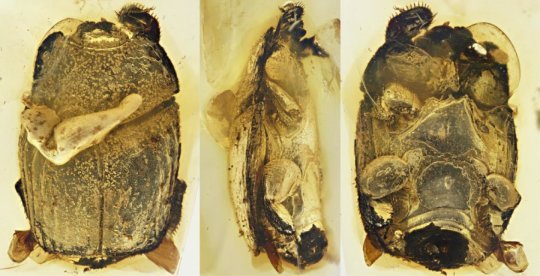 beetle in amber from 100 mya/Parker laboratory, eLife
beetle in amber from 100 mya/Parker laboratory, eLife So what, you say? Well, consider: We have no evidence that the relationship “evolved.” We are informed that we ought to see it as evolution but—as so often—we find the same patterns prevailing in the past, without any evolution. From ScienceDaily:
Almost 100 million years ago, a tiny and misfortunate beetle died after wandering into a sticky glob of resin leaking from a tree in a region near present-day Southeast Asia. Fossilized in amber, this beetle eventually made its way to the desk of entomologist Joe Parker, assistant professor of biology and biological engineering at Caltech. Parker and his colleagues have now determined that the perfectly preserved beetle fossil is the oldest-known example of an animal in a behaviorally symbiotic relationship.
Some of the most complex examples of behavioral symbiosis occur between ants and other types of small insects called myrmecophiles — meaning “ant lovers.” Thanks to ants’ abilities to form complex social colonies, they are able to repel predators and amass food resources, making ant nests a highly desirable habitat. Myrmecophiles display elaborate social behaviors and chemical adaptations to deceive ants and live among them, reaping the benefits of a safe environment and plentiful food.
Ants’ social behaviors first appear in the fossil record 99 million years ago, during the Cretaceous period of the Mesozoic era, and are believed to have evolved not long before, in the Early Cretaceous. Now, the discovery of a Cretaceous myrmecophile fossil implies that the freeloading insects were already taking advantage of ants’ earliest societies. The finding means that myrmecophiles have been a constant presence among ant colonies from their earliest origins and that this socially parasitic lifestyle can persist over vast expanses of evolutionary time.
“This beetle-ant relationship is the most ancient behavioral symbiosis now known in the animal kingdom,” says Parker. “This fossil shows us that symbiosis can be a very successful long-term survival strategy for animal lineages.” Paper. (open access) – Yu-Lingzi Zhou, Adam Ślipiński, Dong Ren, Joseph Parker. A Mesozoic clown beetle myrmecophile (Coleoptera: Histeridae). eLife, 2019; 8 DOI: 10.7554/eLife.44985 More.
Note: “Now, the discovery of a Cretaceous myrmecophile fossil implies that the freeloading insects were already taking advantage of ants’ earliest societies.” So does that mean that if we are told, “Beetles evolved to live alongside ants,” we can object that there is no evidence for evolution of the tendency? Or is that Wrongthink?
If the structuralists are right, these patterns are governed by larger forces of mathematics, physics, and chemistry as opposed to natural selection acting on random mutation (Darwinism). Evidence for a structuralist view would be the immediate adoption of a pattern that works, as opposed to trial and error along Darwinian lines. So far, structuralism is a better interpretation of this relationship.
See also: Pest Insect Gets Plants To Transmit False Information To Other Plants
and
Stasis: Life goes on but evolution does not happen
Follow UD News at Twitter!
Copyright © 2019 Uncommon Descent . This Feed is for personal non-commercial use only. If you are not reading this material in your news aggregator, the site you are looking at is guilty of copyright infringement UNLESS EXPLICIT PERMISSION OTHERWISE HAS BEEN GIVEN. Please contact legal@uncommondescent.com so we can take legal action immediately.
Plugin by Taragana
April 21, 2019
Healthcare analyst: Religion is good for health but its effects are hard to study
Generally, studies have shown a positive relationship between religion and health:
Which is why it is surprising in 2019 that there is still little quantitative research published in peer-reviewed journals exploring the relationship between spirituality, religiosity and health. A primary reason for the lack of institutional knowledge in this area of study is that as the centuries have progressed, scholars in fields of medicine, public health, psychology, sociology, spirituality, religion, economics and law, have all gone to distinct silos. Subsequently, there is a growing body of research, but it exists in disparate fields, with little overlap addressing the implications of health and health care. There is also much contention about working definitions of terms like “religious” and “spiritual,” making research difficult to standardize and impossible to randomize. Nicole Fisher, “Science Says: Religion Is Good For Your Health” at Forbes
Overall, one suspects that many researchers would rather explain the facts away than research them. That said, Fisher offers much interesting data.
Note: Some people would argue that the true relationship is between spirituality and health rather than religion and health. They have a point – up to a point. Insofar as a religion might actually forbid some unhealthy lifestyle practices like drinking or smoking, adherence to the religion itself could result in a better health score.
Follow UD News at Twitter!
See also: If naturalism can explain religion, why does it get so many basic facts wrong?
and
Evolutionary conundrum: is religion a useful, useless, or harmful adaptation?
Copyright © 2019 Uncommon Descent . This Feed is for personal non-commercial use only. If you are not reading this material in your news aggregator, the site you are looking at is guilty of copyright infringement UNLESS EXPLICIT PERMISSION OTHERWISE HAS BEEN GIVEN. Please contact legal@uncommondescent.com so we can take legal action immediately.
Plugin by Taragana
For the first time, “No Religion” is the most popular choice for Americans
Tying Catholicsm and evangelicalism,:
“‘Religious nones’ as they are called by researchers, are a diverse group made up of atheists, agnostics, the spiritual, and those who are no specific organized religion in particular. A rejection of organized religion is the common thread they share,” CNN reports.
“It is the first time we have seen this. The same questions have been asked for 44 years,” political scientist and Baptist pastor Ryan Burge told CNN. Timothy Meads, “ICYMI: ‘No Religion’ Now As Popular As Catholicism, Evangelicalism” at Townhall
While there is certainly a decline in organized religion in the Western world, in North America the near-collapse of mainline Protestantism is the main driver of the current numbers.
Put another way, people who, forty years ago, would have cited the church their parents once attended as their “religion” now say “no religion.” That’s probably because, in current urban society, they no longer experience social penalties for being honest. It’s still a decline but to discuss it intelligently, we need to see clearly what it is a decline in.
Note; The survey involved only 2000 people but it probably does capture an important trend.
Follow UD News at Twitter!
See also: MIT prof was smarter than God
and
Swedish Mathematician Explains Why He Sees Design In Nature (And Became A Christian)
Copyright © 2019 Uncommon Descent . This Feed is for personal non-commercial use only. If you are not reading this material in your news aggregator, the site you are looking at is guilty of copyright infringement UNLESS EXPLICIT PERMISSION OTHERWISE HAS BEEN GIVEN. Please contact legal@uncommondescent.com so we can take legal action immediately.
Plugin by Taragana
Easter Sunday viewing: a dramatised “Case for Christ” by Lee Strobel
Here:
Food for thought. (More here.) END
Copyright © 2019 Uncommon Descent . This Feed is for personal non-commercial use only. If you are not reading this material in your news aggregator, the site you are looking at is guilty of copyright infringement UNLESS EXPLICIT PERMISSION OTHERWISE HAS BEEN GIVEN. Please contact legal@uncommondescent.com so we can take legal action immediately.
Plugin by Taragana
Here’s a pop Darwin look at the origin of religion
At the BBC, a writer offers an explanation of the Christian practice of Communion, Darwinism-style:
But food-sharing even predates our Homo ancestors, and is currently observed in chimpanzees and bonobos. In fact, one recent paper even documented research of bonobos sharing food with bonobos outside of their own social group. Barbara Fruth, one of the study’s authors, told the digital magazine Sapiens that meal-sharing “must have its roots in our last common ancestor”. Based on the molecular clock, the last common ancestor, or LCA, of humans and Great Apes lived about 19 million years ago.
When I hear the words “This is my Body,” then, my mind immediately launches into a race to the evolutionary starting line, if you will. Brandon Ambrosino, “How and why did religion evolve?” at BBC
Along the way, he discovers that apes are spiritual:
Goodall has observed a similar phenomenon happen during a heavy rain. These observations have led her to conclude that chimpanzees are as spiritual as we are. “They can’t analyse it, they don’t talk about it, they can’t describe what they feel. But you get the feeling that it’s all locked up inside them and the only way they can express it is through this fantastic rhythmic dance.” In addition to the displays that Goodall describes, others have observed various carnivalesque displays, drumming sessions, and various hooting rituals. Brandon Ambrosino, “How and why did religion evolve?” at BBC News
We await the ape version of the Summa Theologica but in the meantime, we will settle for the Westminster Catechism.
Follow UD News at Twitter!
See also: Are apes entering the Stone Age?
and
Imagine a world of religions that naturalism might indeed be able to explain
Copyright © 2019 Uncommon Descent . This Feed is for personal non-commercial use only. If you are not reading this material in your news aggregator, the site you are looking at is guilty of copyright infringement UNLESS EXPLICIT PERMISSION OTHERWISE HAS BEEN GIVEN. Please contact legal@uncommondescent.com so we can take legal action immediately.
Plugin by Taragana
Logic & First Principles, 18: What is time? (Thence, what of heat death? The proposed infinite past? Etc.?)
“What is time?” is a misleadingly simple question, one that soon surfaces many difficulties. That is, it is a philosophical issue: phil, being the study of hard big questions. However, it is clear that we need to ponder it here at UD at least at a basic level, if we are to examine relevant concerns such as cosmological fine tuning and the evident beginning of the observed cosmos in a singularity, currently typically projected as about 13.8 billion years ago . . . the following chart based on WIMAP has 13.77 BYA and starts with “quantum fluctuations” leading to a super-luminous stretching of space called inflation:
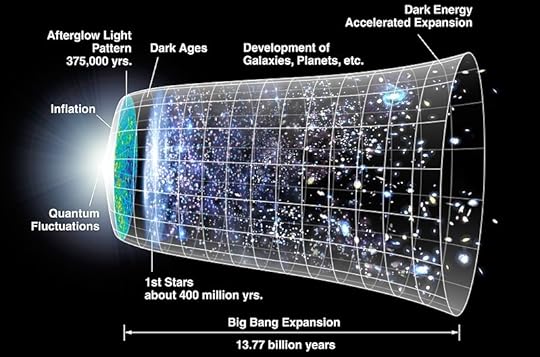
However, we still have not yet resolved the question at even first level. A good start (we must encourage the Wikipedians when they do reasonably well) is this from Wiki:
Time is the indefinite continued progress of existence and events that occur in apparently irreversible succession through the past, in the present, and the future. Time is a component quantity of various measurements used to sequence events, to compare the duration of events or the intervals between them, and to quantify rates of change of quantities in material reality or in the conscious experience. Time is often referred to as a fourth dimension, along with three spatial dimensions.
Time has long been an important subject of study in religion, philosophy, and science, but defining it in a manner applicable to all fields without circularity has consistently eluded scholars. Nevertheless, diverse fields such as business, industry, sports, the sciences, and the performing arts all incorporate some notion of time into their respective measuring systems.
Time in physics is unambiguously operationally defined as “what a clock reads”.
(HT: Wiki, links and footnotes omitted)
What a clock reads is a key clue.
For, it points to causal-temporal succession, thus to enabling energy flows from regions of concentration that allow orderly forced motion (i.e. physical work) thus apparently regular oscillations — cyclical, repeated hopefully regular processes — that can be accumulated as a local index of the passage of time, e.g. through a watch:
 A modern watch movement, an example of both functionally specific, complex information and irreducible complexity of well-matched core functional parts
A modern watch movement, an example of both functionally specific, complex information and irreducible complexity of well-matched core functional partsThis immediately brings out the famed “arrow of time,” entropy.
For, a key driving force behind a process is the flow of energy from zones of high concentration (thus, high order or organisation or at least high temperatures serving as heat reservoirs for heat engines) through systems and processes to heat sinks.
That is, time is closely connected to thermodynamics, and onwards to the projected heat death of the observed cosmos (considered as a thermodynamically isolated system). Wiki also has a useful summary on heat death, which I will clip:
The heat death of the universe, also known as the Big Chill or Big Freeze,[1] is an idea of an ultimate fate of the universe in which the universe has evolved to a state of no thermodynamic free energy and therefore can no longer sustain processes that increase entropy. Heat death does not imply any particular absolute temperature; it only requires that temperature differences or other processes may no longer be exploited to perform work. In the language of physics, this is when the universe reaches thermodynamic equilibrium (maximum entropy).
If the topology of the universe is open or flat, or if dark energy is a positive cosmological constant (both of which are consistent with current data), the universe will continue expanding forever, and a heat death is expected to occur,[2] with the universe cooling to approach equilibrium at a very low temperature after a very long time period.
The hypothesis of heat death stems from the ideas of William Thomson, 1st Baron Kelvin (Lord Kelvin), who in the 1850s took the theory of heat as mechanical energy loss in nature (as embodied in the first two laws of thermodynamics) and extrapolated it to larger processes on a universal scale.
In short, if the cosmos is an isolated system (no mass, energy or information passes into or out of it) then it is headed for a point where as energy resources have been dissipated, physical change ceases, clocks cease and effectively time itself considered as what clocks measure ceases.
The thermodynamics of heat engines is king, in short:

This directly speaks to the proposed infinite past (on the speculation that the big bang represents a fluctuation or the like in a wider cosmos as a whole). For, in transfinite time, any finite reservoir of high quality, concentrated energy will be exhausted. And if one proposes an infinite reservoir in the macro-cosmos, then that requires an equally infinite sink, or else the overall entity will cook itself into a high temperature heat death. Nor do random fluctuations seem to be plausible candidates for creating random pools of order on the scope of our observed cosmos. (Indeed, we would overwhelmingly expect to see a Boltzmann Brain micro-cosmos or the like, rather than the sort of extended entity we see. On a fluctuation, poof, such a brain which perceives a world then poof, gone.)
In this context, Sean Carroll of Caltech is interesting:
I’m trying to understand how time works. And that’s a huge question that has lots of different aspects to it. A lot of them go back to Einstein and spacetime and how we measure time using clocks. But the particular aspect of time that I’m interested in is the arrow of time: the fact that the past is different from the future. We remember the past but we don’t remember the future. There are irreversible processes. There are things that happen, like you turn an egg into an omelet, but you can’t turn an omelet into an egg.
And we sort of understand that halfway. The arrow of time is based on ideas that go back to Ludwig Boltzmann, an Austrian physicist in the 1870s. He figured out this thing called entropy. Entropy is just a measure of how disorderly things are. And it tends to grow. That’s the second law of thermodynamics: Entropy goes up with time, things become more disorderly. So, if you neatly stack papers on your desk, and you walk away, you’re not surprised they turn into a mess. You’d be very surprised if a mess turned into neatly stacked papers. That’s entropy and the arrow of time. Entropy goes up as it becomes messier.
So, Boltzmann understood that and he explained how entropy is related to the arrow of time. But there’s a missing piece to his explanation, which is, why was the entropy ever low to begin with? Why were the papers neatly stacked in the universe? Basically, our observable universe begins around 13.7 billion years ago in a state of exquisite order, exquisitely low entropy. It’s like the universe is a wind-up toy that has been sort of puttering along for the last 13.7 billion years and will eventually wind down to nothing. But why was it ever wound up in the first place? Why was it in such a weird low-entropy unusual state?
That is what I’m trying to tackle. I’m trying to understand cosmology, why the Big Bang had the properties it did. And it’s interesting to think that connects directly to our kitchens and how we can make eggs, how we can remember one direction of time, why causes precede effects, why we are born young and grow older. It’s all because of entropy increasing. It’s all because of conditions of the Big Bang.
He goes on to discuss multiverse models (note, here, that the Boltzmann brain type fluctuation will utterly dominate such models):
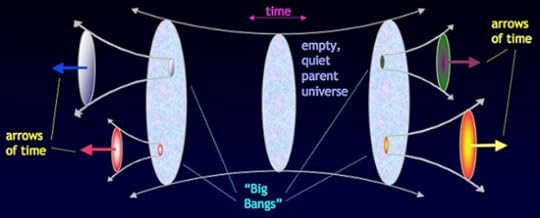
If you find an egg in your refrigerator, you’re not surprised. You don’t say, “Wow, that’s a low-entropy configuration. That’s unusual,” because you know that the egg is not alone in the universe. It came out of a chicken, which is part of a farm, which is part of the biosphere, etc., etc. But with the universe, we don’t have that appeal to make. We can’t say that the universe is part of something else. But that’s exactly what I’m saying. I’m fitting in with a line of thought in modern cosmology that says that the observable universe is not all there is. It’s part of a bigger multiverse. The Big Bang was not the beginning.
And if that’s true, it changes the question you’re trying to ask. It’s not, “Why did the universe begin with low entropy?” It’s, “Why did part of the universe go through a phase with low entropy?”
(Notice, how a highly speculative suggestion has been used as though it had the kind of observational support that backs the singularity. And, notice, how the Boltzmann brain domination of such fluctuation models is not headlined. Indeed, Boltzmann comes up multiple times in the interview but Boltzmann brain is not mentioned. Nor is there an evaluation of implications of entropy for the very long term in a supposedly infinite duration quasi-physical cosmos. Such exemplifies how science can sometimes slide into philosophy without a proper comparative difficulties evaluation; inadvertently begging big questions.)
Let me use Wiki speaking against its general ideological bent:
a Boltzmann brain is a self-aware entity that arises due to extremely rare random fluctuations out of a state of thermodynamic equilibrium. For example, in a homogeneous Newtonian soup, theoretically by sheer chance all the atoms could bounce off and stick to one another in such a way as to assemble a functioning human brain (though this would, on average, take vastly longer than the current lifetime of the universe). The idea is indirectly named after the Austrian physicist Ludwig Boltzmann (1844–1906), who in 1896 published a theory that the Universe is observed to be in a highly improbable non-equilibrium state because only when such states randomly occur can brains exist to be aware of the Universe. One criticism of Boltzmann’s “Boltzmann universe” hypothesis is that the most common thermal fluctuations are as close to equilibrium overall as possible; thus, by any reasonable criterion, human brains in a Boltzmann universe with myriad neighboring stars would be vastly outnumbered by “Boltzmann brains” existing alone in an empty universe.
Boltzmann brains gained new relevance around 2002, when some cosmologists started to become concerned that, in many existing theories about the Universe, human brains in the current Universe appear to be vastly outnumbered by Boltzmann brains in the future Universe who, by chance, have exactly the same perceptions that we do; this leads to the absurd conclusion that statistically we ourselves are likely to be Boltzmann brains. Such a reductio ad absurdum argument is sometimes used to argue against certain theories of the Universe. When applied to more recent theories about the multiverse, Boltzmann brain arguments are part of the unsolved measure problem of cosmology.
Coming back, you may notice that clocks measure local time. This reflects relativity, where velocity and separation affect perceived simultaneity and the perceived lapse of time. That is a significant issue, but it does not remove the validity of the temporal-causal succession macro-scale view of time.
In this context, a significant discussion on a suggested infinite in the past macro-cosmos arose in a prior thread on hyperreals, infinitesimals etc.
To set context, allow me to show the surreals panorama in which the reals appear after w steps of construction, as the first vertical bar, with the integers as mileposts:
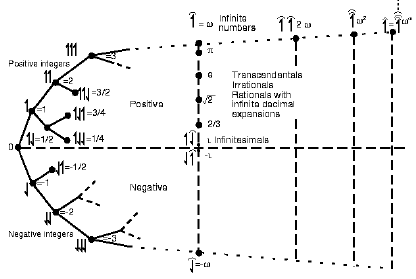
Likewise, following Dr Carol Wood, we may identify a hyperreal, K such that 1/K is an infinitesimal, which I have termed m:
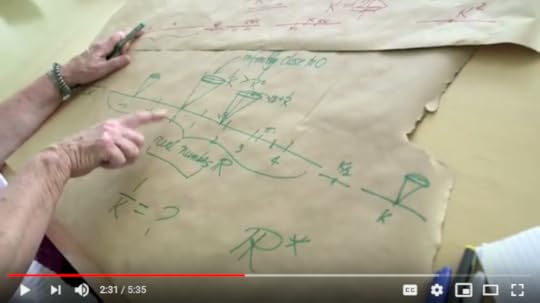
I clip here a comment I made in the discussion (which I hope is helpful to those troubled by infinite past within the reals claims):
KF, 165: >> there is no definable last finite integer ranging out L-wards step by step from 0 [–> in effect, 0, -1, -2 . . . -k, -(k+1) . . . without limit where k is any arbitrary typically large (and finite! . . . note, bound by k+1), particular distinct natural number we may symbolise]. Likewise, there is no definable least transfinite descending K, K-1, K-2, . . . K/2, . . . which is mirrored on the L-ward side, just harder to represent. [–> Here, K is a hyperreal so that 1/K = m, an infinitesimal closer to 0 than 1/k = n, for any k in the naturals, N.) We have a fuzzy border lurking under the seemingly simple ellipsis.
Take the hyperbolic 1/x catapult down towards 0 and we have -m = 1/-K which is closer to zero than 1/-k for any -k in Z-. Shift the resulting infinitesimal cloud anywhere along the reals, to r in R. [Just add 0 + cloud to r.] There is no definable closest real to r, part of there being a continuum. Also, there are hyperreals yet closer to r than any neighbouring real. The fuzzy border phenomenon appears around every real.
Coming back, I already wrote to you:
Z- never begins: { . . . -2, -1, 0} but that’s the point. To get to -2 temporally [considering the past stages as labelled with numbers for convenience] you have to descend down the full beginningless span of that ellipsis. Where for every stage Q finitely removed from -2, {. . . Q, . . . -2, -1, 0} you have had to descend to Q-2, Q-1, i,e, the chain replicates L-wards beyond Q in direct copy of to 0, i.e. the span is demonstrably infinite L-wards. And EVERY Q takes in the claim that the whole chain L-wards comprises finite values so that Q is bound by Q-1 for every Q in Z-. The chain is indeed beginningless L-wards in the sense of infinite.
In short we can do an L-wards 1:1 for every Q in Z-:
{. . . Q-2, Q-1, Q}
{ . . . -2, -1, 0}That is we see a self-similar copy of Z- appearing L-wards at every Q, i.e. the set is infinite L-wards. This is sledgehammer to peanut.
There is no identifiable L-wards first element of Z-, that’s what we ALL know the ellipsis means, and that therefore every identifiable Q in Z- is bound by an indefinite onward extension L-wards.
It is the consequence of this when we apply it to succession of temporal-causal stages approaching to Q from L-wards going R-wards that the significance appears. From Q L-wards, we have a copy L-shifted of from 0 L-wards, i.e. the order type of the succession L-wards from Q is w, of cardinality aleph null. We have not got away from the supertask of descent down a transfinite span, we still face it. Such a span cannot be bridged going R-wards to approach Q no more than it can be spanned going R-wards from 0.
This is the familiar supertask of spanning the transfinite in steps.
Going further, an argument that in effect holds that at every Q in Z- that is in finite span of 0 [having been constructed in the set builder sense by mirror image of the von Neumann construction] is a stage where the L-wards transfinite has already been spanned so is not a problem, fails.Fails by begging the question at issue. Spanning an actual past of step by step successive stages from a “beginningless” past.
We find here no warrant for begging or setting the question aside.
We are only warranted to address finitely remote past points Q that do not involve an antecedent transfinite span to Q.Credibly, there was no beginningless past that advanced by successive cumulative stages to the present.
Such a claim would require a supertask essentially similar to descent to now from a defined transfinitely remote stage, -K.>>
Going beyond, for example there is the famous A vs B theory debate: rather roughly, on the A view there is NOW, which progresses so that the past has gone and does not exist as such, it is an abstraction (albeit one that thanks to cause has marked the present) just as is the future. Here, unidirection of cause is such that the actual future cannot act causally in the now, it is its not yet emerged result. The B theory is more perspectival, seeing time as a panorama and our present as our particular for the moment point of view. In effect, events of a certain famous weekend in 30 AD just outside Jerusalem are just as real (but “past-wards” — strictly, “earlier than” — from us) as is our now this Easter Sunday, and as is the as yet unperceived future (strictly “later than”). And of course, the onward obvious point is: are there forks so there are multidimensional temporal timelines . . . a significant view in Quantum Mechanics.
Huge, hotly debated issues hinge on the implications and challenges embedded in these views. In short, time is a pivotal, foundational concept.
There is of course much more to time, but the above is enough to spark thought onwards. END
Copyright © 2019 Uncommon Descent . This Feed is for personal non-commercial use only. If you are not reading this material in your news aggregator, the site you are looking at is guilty of copyright infringement UNLESS EXPLICIT PERMISSION OTHERWISE HAS BEEN GIVEN. Please contact legal@uncommondescent.com so we can take legal action immediately.
Plugin by Taragana
Michael J. Behe's Blog
- Michael J. Behe's profile
- 219 followers



